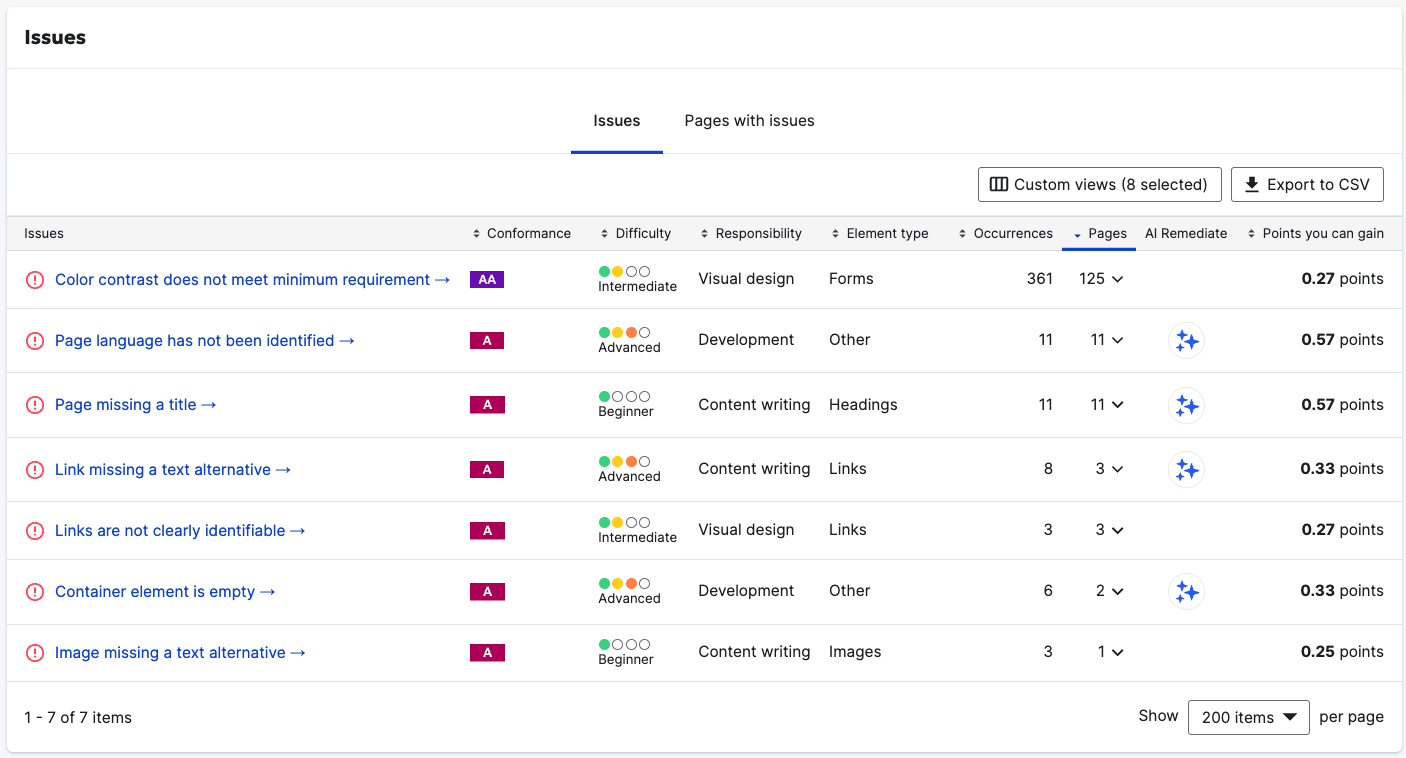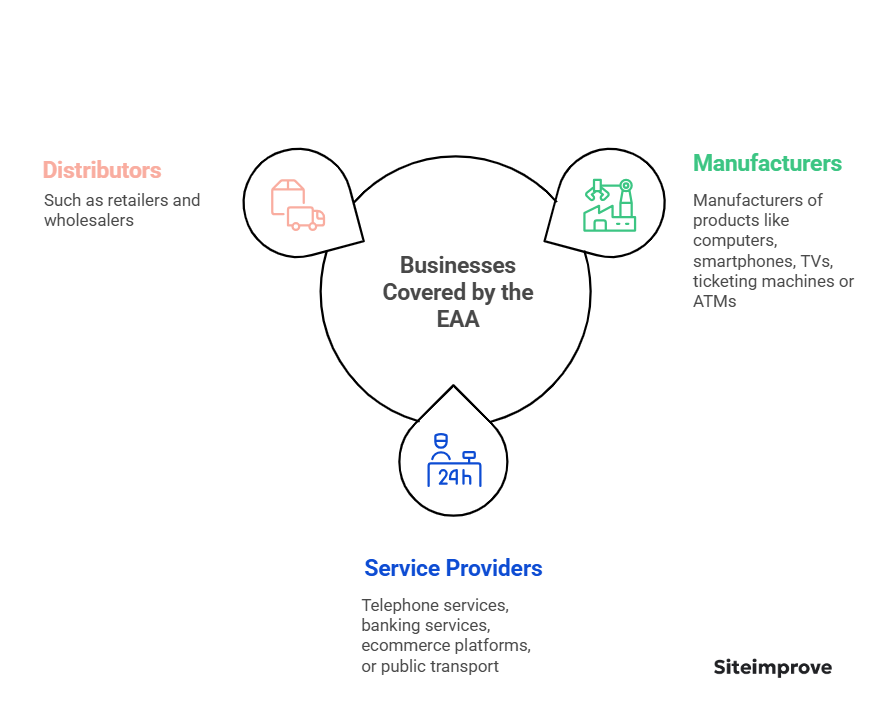The deadline for the European Accessibility Act (EAA) was June 28, 2025. If your site is not fully compliant, have no fear: Siteimprove can help you catch up quickly.
For some B2B companies, it takes months to get their digital strategy fully oriented to accessibility, make and execute a plan, and then run automated and manual testing to make sure it’s on top of every detail and resolved every issue.
If you’re just getting your feet wet with the ins and outs of EAA, we’re here to guide you through specific requirements outlined so your business is compliant and legal risk is mitigated.
What is EAA and what will be its impact?
The EAA aims to standardize regulations among EU member states to make digital products and services more accessible to individuals with disabilities. It mandates accessibility compliance, and it’s designed to benefit both businesses and individuals: Businesses benefit from shared rules on accessibility across the EU, and these harmonized accessibility standards mean access to large market opportunities across Europe, (disabled people make up a large market segment), while persons with disabilities have better access to products and services, transport, education, and jobs.
Each EU member state is required to implement the EAA, so businesses operating in their jurisdiction comply with the standardized accessibility regulations.
It’s a critical piece of legislation from several perspectives. First of all, legal adherence isn’t optional: In most cases, you have to adhere to it and make sure that all of your digital content, including websites, apps, and documents, is accessible to people with disabilities. It’s also simply the right thing to do — everyone should be able to participate in digital experiences and use digital products and services as much as possible, just like any other experience.
But it’s also critical from a business perspective: According to WHO, about 16 percent of the world population experience significant disability, which adds up to a lot of buying power. As The Drum puts it, “Businesses could be sacrificing millions in potential spend because of outdated websites, apps, designs, tech, or systems that cannot cater to this demographic.”
Ultimately, EAA is designed to extend to businesses a larger advantage: the seamless flow of accessible products and services across all EU nations, which reduces costs.
Standardized accessibility rules across the EU, so the thinking goes, will expand customer choices and foster greater market growth and innovation, too.
As for the cost savings, those are massive: The EU Commission estimates that differing accessibility requirements cost companies and member states €20 billion in 2020, and that the new EAA harmonization will reduce that by 45 to 50 percent.
The web must be clear. Laws demand it. Siteimprove finds the problems on your pages, and it helps you fix them so you stay right.

Ensure Your Digital Presence is EAA Compliant: Visit our comprehensive EAA Resource Center for essential guides, checklists, and tools to help you navigate compliance and create a more inclusive digital experience.
Where does EAA apply, and how is it relevant for B2B organizations?
EAA doesn’t just apply to businesses based within the EU, but rather pretty much any entity that does business in the EU. That means it applies if you’re selling goods and services to customers there; working with a company that produces, distributes, or supplies and services in the EU; or if you’re a public agency.
How does WCAG fit in with EAA?
The Web Content Accessibility Guidelines (WCAG) are more or less built into EAA and many other disability laws around the world: They establish shared standards, and adhering to a particular version, such as WCAG 2.1, is crucial for meeting EAA compliance and providing an accessible digital experience.
Both WCAG and EAA address all sorts of common accessibility issues, such as insufficient color contrast and inaccessible CAPTCHA systems. If your digital content meets WCAG, then it aligns with EAA.
Here are examples of businesses covered by the EAA:
- Manufacturers of products like computers, smartphones, TVs, ticketing machines, or ATMs
- Service providers, e.g., telephone services, banking services, ecommerce platforms, or public transport
- Distributors such as retailers and wholesalers
In terms of exemptions, the EAA does exclude “micro-enterprises,” which are companies with fewer than 10 employees and an annual balance sheet total not exceeding Є2 million.

Additionally, certain types of material are exempt, such as:
- Pre-recorded time-based media (e.g., videos) published before June 2025
- Office file formats published before June 2025
- Online maps, if essential information is otherwise provided in an accessible way
- Third-party content that is not funded, developed, or under the control of an organization that must be compliant
- Archived content that won’t be updated after June 2025
There is, however, some nuance in terms of its application to B2B businesses: If a site exclusively sells products and services to B2B businesses, then EAA doesn’t apply, but if the site serves both B2B and B2C businesses, then EAA does apply. If, for example, you have an ecommerce site like Alibaba or Amazon Business that sells only to B2Bs, then technically it doesn’t have to observe EAA.
But just because it doesn’t have to doesn’t mean it shouldn’t.
Firstly, and in line with the spirit of the EAA, remember that while you’re selling to other businesses, those businesses are still made up of people, and if, as mentioned above,16 percent of the world population lives with a significant disability, there's a good chance that the buyer-representative you're selling to has some form of disability. It makes good business sense to ensure that you create a frictionless digital experience for them.
Secondly, let's say that your B2B business creates technology or software that’s then sold to B2C businesses in the public or private sector. Because those businesses need to be EAA compliant, they are therefore prioritizing accessibility compliance in their buying decisions and will also want to ensure that their offerings are EAA compliant.
Overhauling your digital presence and ensuring your offerings appeal to buyers who require EAA compliance (and by extension WCAG compliance) takes resources and strategic planning. For large or complex sites, as noted, it can take literally months to plan, execute, and do manual and automated testing to make sure every item is complete, across every digital platform.
Compliance aside, accessibility is not a ‘one-and-done' project; rather, it’s a guiding principle to be woven into all aspects of business, from hiring practices to product development or content creation. But that doesn’t mean there aren’t resources available to guide your journey.
One resource worth checking out: The European Disability Forum, which provides insights and advocacy on disability issues. It’s an NGO that’s run by people with disabilities and their families and advocates for the 100 million people in Europe with disabilities; you can collaborate with them to understand the needs and expectations of individuals with disabilities.
The Siteimprove EAA Checklist is a simple, straightforward resource that takes you through the most common digital accessibility issues, from insufficient color contrasts to CAPTCHA systems to lack of screen reader compatibility. Think of it as your first step towards a strategic plan to achieve EAA compliance (including automated and manual testing).
Additional resources
The European Accessibility Act: FAQs: Find out more about how the EAA covers software, web, and services.
The importance of web accessibility for businesses of all sizes: Even very small companies are at risk if their website isn’t fully accessible.
Overview of UK accessibility laws for websites: The UK’s major disability legislation falls under the Equality Act 2010. It applies to both public and private entities.
Accessibility and inclusivity: Two pillars of brand integrity: When your website is fully accessible, you’re welcoming all your customers and potential customers.
Have questions about how to remediate these issues, or how to best plan for compliance? Our team is always happy to help. Reach out today to book a meeting.
Ready for EAA compliance?
Download our free EAA checklist today and learn everything you need to know about achieving website accessibility compliance.
Download the checklist


